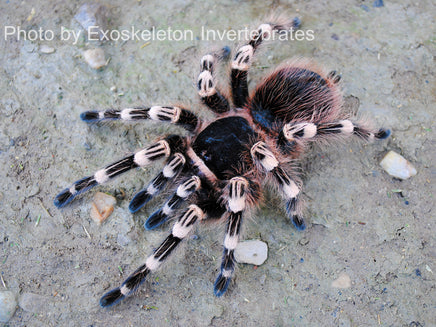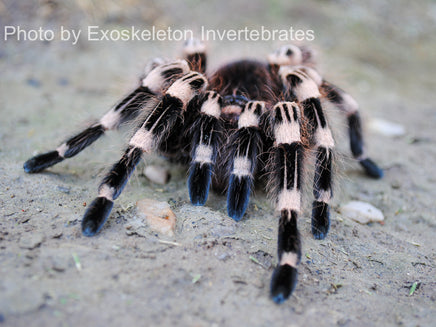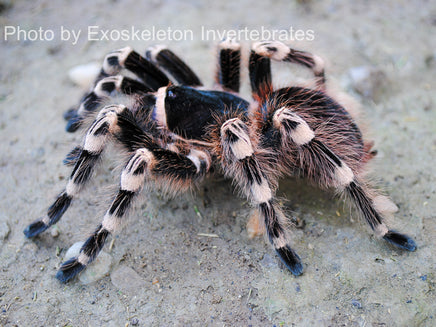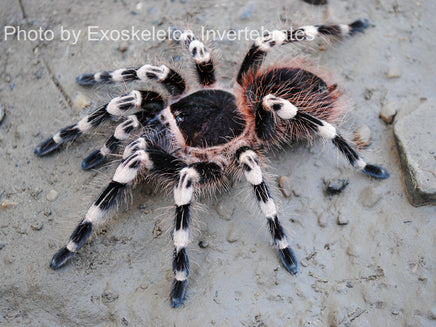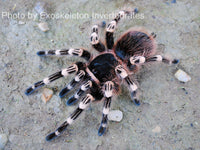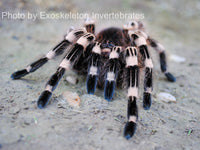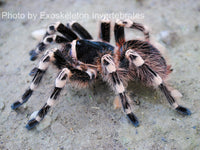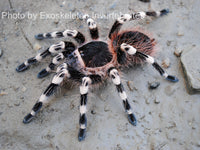Say hello to the Acanthoscurria geniculata, a species that stands out in the tarantula community for its robust size and striking appearance. Commonly known as the Brazilian Whiteknee, this species showcases bold black and white banding on its legs, creating a stunning contrast that's hard to miss. Native to the rainforests of Brazil, the Brazilian Whiteknee is known for its voracious appetite and rapid growth rate, making it an exciting species to watch and care for. Ideal for those who appreciate a more active and visibly engaging tarantula, it adds both drama and beauty to any collection.
Care Details:
-
Temperature: The Acanthoscurria geniculata thrives in a temperature range of 75 to 85°F (24 to 29°C). In these warmer conditions, they exhibit faster growth and more frequent molting, yet they are adaptable and relatively easy to care for.
-
Humidity: This species prefers a humidity level around 60-70%. While I don't use water dishes, they can be included without causing harm to your tarantula.
-
Housing: As a terrestrial species, the Brazilian Whiteknee requires a ground-focused enclosure. For babies, I recommend a 1 oz to 4oz deli container with needle-made ventilation. Don’t forget, I provide these containers free at checkout, but you need to request one. For larger specimens, an enclosure that is 2 to 3 times their leg span in size will suffice, allowing them some flexibility in their habitat.
-
Diet: I feed my Acanthoscurria geniculata a varied diet of crickets and cockroaches, including Dubia, Red-runner, and Lobster roaches. Babies do well with smaller prey. If your available prey is too large, crush its head and place it in the enclosure. Remember to remove uneaten food to prevent mold. Occasional treats like a pinky or hopper mouse are great, but should be given sparingly to avoid excessive calcium intake.
In-depth Facts:
- Latin Name: Acanthoscurria geniculata
- Common Names: Brazilian Whiteknee Tarantula
- Locale: Originating from the rainforests of Brazil.
- Category: Terrestrial, usually out and about.
- Size: Females can reach up to 8+ inches in leg span, with males being slightly smaller.
- Urticating Hairs: Yes, they possess urticating hairs.
- Growth Rate: Rapid. One of the faster-growing species acanthoscurria species.
- Life Span: Females can live up to 12-14 years, while males have a shorter lifespan.
- Recommended Levels: Suitable for all levels, but their quick growth and size might be better appreciated by keepers that love larger species.
Stay Connected:
- Instagram: Follow my Instagram, I'm most active here.
- YouTube: For care and education videos, check out my YouTube channel.
- Facebook: Over here I have all my reviews.
- TikTok: Visit my TikTok for additional content.
Safety Disclaimer:
Experiencing a tarantula bite is an extremely rare occurrence, and it's important to note that there have been no recorded fatalities due to a tarantula bite. The venom potency varies across species, with Old World tarantulas generally having stronger venom than their New World counterparts.
It's crucial to approach tarantulas with respect and understanding. If you happen to get bitten, which is unlikely, the key is to stay calm. In most cases, the discomfort is superficial and subsides within a few minutes to a few hours. However, bites from species with more potent venom may result in symptoms lasting up to a week. Remember, larger tarantulas tend to have more venom than smaller ones.
Please be aware that I cannot assume responsibility for bites. Tarantula handling should be done at your own risk. In my 11 years of experience with these creatures, I have only been bitten once, by a species with highly potent venom. While the experience was painful, the symptoms had completely disappeared after a week.
Handle tarantulas responsibly, and always prioritize your safety and the well-being of the tarantula.
